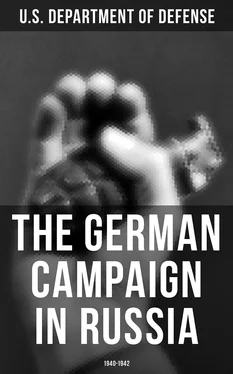The Russians would probably try to stem the tide by defending prepared positions along the new and former borders as well as by holding the numerous river lines west of the Dnepr and Dvina Rivers. It was to be expected that the Soviet command would make a special effort to hold the Baltic States and the coastal provinces along the Black Sea as long as possible in order to keep important air and naval bases in its possession. If the battles southeast and northeast of the Pripyat Marshes took an unfavorable turn for the Russians, the next attempt to stop the German offensives would probably be made along the Dnepr and Dvina.
After stating the overall mission of each army group, the order assigned the specific tasks as follows:
a. Army Group South. This army group was to assemble two strong attack forces, one along the Prut River in Romania, the other in the Lublin-Jaroslav area. [See map 3 .] These two forces were to thrust in the direction of Kirovograd and Kiev respectively, and thus accomplish a double envelopment of Russian forces in the western Ukraine. The significance of Kiev as the capital of the Ukraine, the headquarters of one of the most important military districts of the Soviet Union and the site of vital bridges across the Dnepr, was unquestioned. Here, too, was the point from which, after the initial border engagements, Army Group South was to coordinate any further advance with the movements of Army Group Center.
The southern arm of the pincers was the Twelfth Army, consisting of German and Romanian divisions and including one motorized infantry and two armored divisions. It was to drive northeastward via Kirovograd toward the Dnepr. The connecting link between the two prongs was to be the relatively weak Seventeenth Army, which had no armored units. Since neutral Hungary's territory was not to be used, this army was to assemble southeast of Lublin and advance toward Vinnitsa and Berdichev, in order to pin down the front of the Russian forces that were threatened by a double envelopment.
Forming the northern arm of the pincer, Sixth Army was to assemble in the Lublin area together with First Panzer Group. These two forces were given the most important as well as the most difficult task within the Army Group South mission. They would have to carry the main effort and, in addition to breaking through to Kiev and participating in the encirclement of the Russian forces in the western Ukraine, Sixth Army would have to screen the army group's north flank along the Pripyat Marsh region. In its distribution of attack forces the Army High Command had not allocated any combat elements of this region on the assumption that it was unsuitable for major operations and could therefore simply be kept under observation. In view of the unsatisfactory manpower situation, the Army High Command preferred to save forces for employment in more important attack zones.
After Sixth Army and First Panzer Group had succeeded in breaking through the enemy front, the latter was to speed toward Zhitomir, establish bridgeheads on the east bank of the Dnepr at Kiev and below, wheel southeastward to hit the enemy flank and rear, and link up with Twelfth Army. Covering the left flank of the advancing armor along the Pripyat Marshes, Sixth Army was to follow the First Panzer Group as quickly as possible, first to Zhitomir and then to Kiev. During its direct thrust across the territory west of the Dnepr, Sixth Army was to earmark strong forces for a sudden southeastward diversion.
b. Army Group Center. In the Army Group Center area immediately north of the Pripyat, the Russian salient west of Bialystok offered the possibility for a double envelopment. In this area the principal objective of rapidly destroying major Russian forces seemed more easily attainable than in the area of Army Group South. Exceedingly strong forces were to be massed on both extremities of the army group front while relatively weak ones were to be employed in the center. On the right, Fourth Army, including Second Panzer Group, was to advance along the main highway Baranovichi-Minsk-Orsha, while on the left, Ninth Army, including Third Panzer Group, was to jump off from Suwalki and drive toward Molodechno and Orsha. The objective of these two forces was the encirclement and destruction of all Russian forces between the border and Minsk. Second and Third Panzer Groups were then to move on Smolensk from the southwest and from the northwest respectively, thus preventing a reorganization of enemy forces along the upper Dnepr and Dvina Rivers. Fourth Army was to follow Second Panzer Group, advancing via Bobruysk and Borisov to Mogilev and the area north of that town. At the same time Ninth Army, taking advantage of the Third Panzer Group thrust, was to gain the Dvina at Polotsk and farther upstream.
c. Army Group North. The topography of the Baltic States favored the massing of power on the right of Army Group North. A powerful drive emanating from central East Prussia and directed via Kovno and Dvinsk into the area south of Pskov would cut off the Russian troops stationed in the Baltic States and squeeze them against the Baltic. Moreover, by establishing themselves in the vicinity of Lake Ilmen the German units would be in a favorable position for continuing their advance on Leningrad. The possibility that Army Group Center would support Army Group North was anticipated but was to be made contingent upon Army High Command approval.
At the outset of the operation Fourth Panzer Group, in conjunction with Sixteenth and Eighteenth Armies, was to break through the Russian border defenses in the area bordering on the Gumbinnen-Kovno highway. The armored units were to precede the infantry elements and cross the Dvina at Dvinsk and farther downstream. Their objective was to proceed to the area south of Pskov as quickly as possible, so that they could continue their drive to the north or the northeast in accordance with the overall situation.
After breaking through the Russian border positions, Sixteenth Army was to strengthen its right and follow Fourth Panzer via Dvinsk in the direction of Pskov.

Eighteenth Army was to mass its forces along and east of the Tilsit-Riga highway, break through the Russian lines, cross the Dvina in the vicinity of Yekabpils, and destroy the encircled Red Army forces southwest of Riga. By quickly driving on to Pskov, the army was to prevent the withdrawal of Russian forces from the area southwest of Lake Peipus and set the stage for a subsequent seizure of Estonia and the islands of Hiiumaa and Saaremaa.
At the beginning of the operation the Army High Command reserves were to be moved up to the areas west of Jaroslav and east of Warsaw, where relatively strong forces were to be assembled, and to the Lublin and East Prussian border areas, where weaker groups were to be stationed.
d. Far North. Finland was to coordinate its offensive across the southeastern border with the Army High Command. The Finnish forces could attack either to the east or to the west of Lake Ladoga, and they were to time their offensive to coincide with Army Group North's crossing of the Dvina River.
The Army of Norway was given a defensive and an offensive mission [See map 4 .]:
1. To protect Norway against any landing attempt by the British, and, in particular, to strengthen the defense forces in the Kirkenes-Narvik area.
2. To seize the Petsamo area in Finland in order to secure the nickel mines and to bear down upon the Russian port of Murmansk with the intention of seizing it as soon as the overall situation would make sufficient troops available for this mission.
Читать дальше













